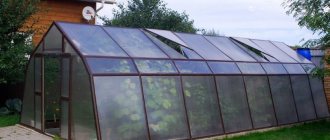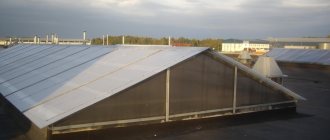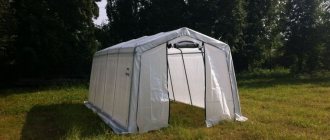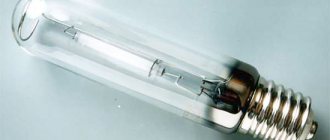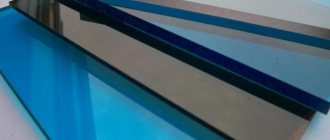Construction technologies do not stand still, and delight us with practical new products that always have a place in private housing construction. Thus, today in Russia monolithic polycarbonate is gaining increasing popularity - a unique, absolutely transparent lightweight material that is 250 times stronger than glass!
Stylish gazebos and canopies are made from it, cozy verandas are glassed, installed as an invisible fence for the roof in use and protect valuable structures from vandals. How can such a weightless coating, similar to a thin layer of ice, have such properties? And where exactly is it used? That's what we'll talk about now!
Monolithic polycrabonate in modern construction
Monolithic polycarbonate is most in demand today for glazing and as roofing. The thickness of the sheet itself can be very different, which will directly affect their strength.
So, for domestic manufacturers it varies from 2 to 12 mm, and from 1 to 20 mm for European ones. And, depending on the thickness and strength of the panels, they are allowed to be used in one area or another:
Verandas and summer cafes are especially beautiful made from monolithic polycarbonate. After all, in the end, the extension remains as transparent and light as with glass (at first glance it’s even difficult to tell the difference), but at the same time much more impact-resistant.
The same ball from children playing in the yard can destroy the most beautiful structures. Moreover, it is unsafe for those drinking on the veranda!
So why not use this durable material instead of glass, and also play with color (bronze or simply darkened is in perfect harmony with wooden or log walls). At the same time, it is not necessary to darken the entire roof and walls - it is enough to block only the part that faces south from the sun:
You will be interested to know that monolithic polycarbonate appeared already in the middle of the twentieth century, and it was patented by a German physicist. And today the global production volume of polycarbonate exceeds 100 thousand tons, which is impressive!
This material has unique characteristics: transparency, like glass, lightness and almost extreme impact resistance. At the same time, monolithic polycarbonate is 10 times and 180 times stronger than ordinary plexiglass. Thanks to these properties, such polycarbonate is successfully used today in the construction of vandal-proof structures.
Of course, due to the lack of internal honeycombs, the heat retention ability of monolithic polycarbonate is much worse than that of cellular polycarbonate. But the deflection radius is larger, which allows you to make beautiful structures from it:
Rules for drilling holes
Let's figure out how to drill polycarbonate and how to do it correctly. Holes in polycarbonate should be drilled between the stiffeners. The distance from the edge should be no less than twice the diameter of the drill.
The conditions for drilling holes are as follows:
- The sharpening of the drill should have an angle of 300.
- Holes must be drilled strictly at right angles at a speed of no more than 40 m/min.
- The hole diameter must be selected so that it exceeds the same parameter of the fastener by 3 mm.
- Work should be interrupted periodically to remove the resulting chips and cool the drill.
Advantages and disadvantages of “plastic glass”
Let's list the main points of difference between monolithic polycarbonate and cellular and other similar materials:
- Transparency. Monolithic polycarbonate, unlike cellular polycarbonate, looks richer. And, at the same time, it loses in this aspect: honeycombs allow light to be gently diffused, and a monolithic sheet allows all direct sunlight to pass through (therefore, it is not very suitable for building a greenhouse, since plants get burned).
- Noise insulation. Polycarbonate is also famous for its high sound-absorbing properties. This is what you often see as fencing for residential buildings from noisy highways, airports and industries.
- Fire safety. Another nice bonus: monolithic polycarbonate is difficult to ignite and belongs to the group of self-extinguishing polymers.
- Durability. The monolith (as builders often call it for convenience) is also resistant to chemical compounds. It can withstand temperatures from -40 to +120C.
- Sustainability. Even in extreme conditions, monolithic polycarbonate does not change its structure and does not deform, and therefore shows its best performance in both hot and frosty climates. Although usually building materials behave completely differently in different conditions.
- Anti-vandal properties. Monolithic polycarbonate is so durable that it is even used for impact-resistant windshields and personal protective equipment.
- Environmental friendliness. And finally, products made from monolithic polycarbonate are not only durable, but can also be recycled if necessary. And this is a plus for everyone who cares about the future of our planet.
Here is a more detailed video review of the qualities of this material:
Although we immediately note that the issue of absolute transparency of monolithic polycarbonate is quite controversial. Unfortunately, after a few seasons, small scratches will still appear on it.
When this happens with a cell phone, it is not as noticeable. This mainly depends on how the material itself was cared for. If you remove snow from such a roof incorrectly, the coating will be scratched. As a result, the sight of such polycarbonate from a neighbor may discourage them from purchasing it for themselves, and this is wrong:
How can you bend the arch?
The bending radius of the arch should not be higher than 20 mm of the material used.
Each type of material in question has its own characteristics on the protective film. These data should be used as a guide.
Let's consider the relationship between the minimum permissible radius and sheet thickness:
| Sheet thickness in millimeters | Radius in millimeters |
| 4 | 0,7 |
| 6 | 1,05 |
| 8 | 1,4 |
| 10 | 1,75 |
| 16 | 2,8 |
| 20 | 3,9 |
Quality issues: what to expect in a couple of years?
Initially, monolithic polycarbonate conquered the world market by deservedly taking first place in strength among all existing transparent materials. It’s not for nothing that they glaze attics and balconies, advertise billboards, cover greenhouse structures, and even cover the entrance to metro stations.
But, unfortunately, the idea of using monolithic polycarbonate in private construction is often abandoned when they see cracked and cloudy material that is only 2-5 years old on stops or balcony canopies.
In fact, low-quality Chinese polycarbonate is almost always used on street buildings and government buildings, which costs much less than the original one.
After all, if we talk about durability, then as an advertising step, monolithic polycarbonate of increased strength was even used for an advertising installation with money, breaking which you could immediately take the entire amount for yourself. And even the most resourceful were not helped either by hammers or a strong kick! So what happens then? The answer is simple: such polycranate simply breaks down under the sun, like any plastic without protection.
By all rights, such protection should be provided in the form of a thin film on a sheet, applied by coextrusion. But some selling companies prove that their UV protection is contained directly in the polycarbonate itself. What raises certain doubts is whether such technology is too expensive?
Indeed, such a polycranate exists, and the volume of such a stabilizer in granules can reach up to 30%! But such material is expensive, and this is certainly not the case when you purchase budget polycarbonate for your veranda at a discount.
In fact, there is a grain of truth here: manufacturers introduce a little UV stabilizing substance into the granules of polycarbonate raw materials. It will allow you to preserve the sheets during long-term storage. But the concentration of this substance is very low, and therefore it cannot be sufficient for full protection.
Yes, indeed, back in the 70s they first encountered the need to protect polycarbonate from ultraviolet radiation. And then the stabilizer was added to the granules, but later almost all manufacturers abandoned this method due to the high cost and unreliability in favor of extrusion. And those copies, in which up to 30% protection is still added directly to the granules, are produced for special tasks, and they last up to 25 years!
And when there is no protective layer in ordinary polycarbonate, things are bad. Rays, acting on polymers in the ultraviolet spectrum, develop reactions of destruction of macromolecules. In simple terms, the polymers themselves become brittle and break down over time. This is why, in the process of manufacturing a monolithic sheet, a light stabilizer is applied to it with a thin layer (only 35-60 microns).
This layer is sufficient for the durability of the coating. It’s just that the thickness of this almost invisible layer is not visible to the eye. Therefore, you will have to trust the seller regarding the number of microns.
And, if you were deceived, get ready for the fact that a sheet without ultraviolet protection can remain intact only for a year, and with less than normal protection - only 5 years. These are exactly the sheets that, after the first hail, are covered with small holes (they like to share their photos on social networks).
And it should be like this: with cellular polycarbonate, protection from UV rays is provided only on one side, while with monolithic polycarbonate, it is protected on both sides. This layer is thin, only 50-80 microns, but still manages to give the sheet additional hardness:
You probably have a question here: why cover both sides of the sheet with UV protective film? After all, the sun cannot possibly shine from inside a terrace or gazebo. It’s quite interesting how the manufacturer explains this: two films on both sides of the sheet are needed so that these sides are not accidentally mixed up.
Indeed, in this case, the polycarbonate will not last long at all, and then the buyer will go to file a claim with the selling company. Among dealers, this technique is secretly called “counting on the fool.”
The second reason: waste-free installation. The presence of a protective film on both sides of the sheet is necessary so that the sheet can be bent or turned over to the side that is needed in any part of the complex structure.
In addition, there are still situations when the sun really shines on the wrong side - in the case of installing advertising structures, fences and transparent buildings on the street. So the film on both sides completely protects the entire mass of the sheet. By the way, some brands of cellular polycarbonate also have double-sided UV protection.
Some useful tips
Polycarbonate, for all its characteristics and advantages, remains a plastic that ages over time, and cracks appear on its surface. In honeycomb slabs, dirt and plants often accumulate inside, and if the ends are not closed, then moss and insects quickly appear inside, which only antiseptics can fight.
If you don’t know which side to put the polycarbonate on the greenhouse towards the sun or you made a mistake, then you shouldn’t disassemble the entire structure. The entire surface can be covered with a protective film, which is used for restoration of paintwork on cars.
Monolithic slabs are more reliable, but also more expensive. However, they are easily susceptible to the appearance of small cracks due to sudden and severe temperature changes. Over time, drops of water and stains will appear across the entire surface. You can remove cracks with solution 646 - it will melt the surface.
You need to be very careful when choosing the design and fastening elements. In this case, the characteristics of the region must be taken into account. For example, in some areas with a temperate climate, you can use the simplest mounting options and not worry about the condition of the greenhouse.
In other regions, not only a reinforced frame will be required, but also durable installation of sheets due to constant and high winds. That is why it is always recommended to contact specialists and work with professionals who know all the intricacies of this material and the rules for its fastening.
Solvent 646 Source www.rapid23.rf
It is inconvenient to screw fasteners into round metal pipes. The axis of the drill must be perpendicular to the surface of the pipe, but this is very difficult. It is recommended to abandon this profile or use an L-shaped attachment for an electric drill.
When using carpentry fasteners, it is recommended to first make several screws on the scraps in order to correctly select the force and speed of the tool.
Types of monolithic polycarbonate by color and shape
Now let's look at the design issue of monolithic polycarbonate, namely its color and shape. Today, most types of monolithic polycarbonate are available in transparent, white and bronze colors.
Even in the factory, paint is added directly to polycarbonate granules. Darker sheets will help protect your vacation spot from the scorching rays of the sun, while brighter sheets will help create the feeling of a festive day.
But the most popular today is transparent monolithic polycarbonate - universal for almost any application. Although colored, with the right approach, it can serve as an effective accent in architectural design. The following shades are in fashion today:
A rather interesting type of monolithic polycarbonate is profiled, which is also called impact-resistant transparent slate. Its shape is similar to corrugated sheeting, but it looks much more impressive. Despite its transparency, it has excellent UV protection. And even hail 20 mm in diameter cannot penetrate such a roof!
The profiled sheet was given a wavy or trapezoidal profile. This material is perfect as a roof for gazebos, extensions and recreation areas. They block markets, street lights and parking lots. In addition, in construction, profiled polycarbonate is used for cladding buildings.
Let's compare it with a regular flat sheet:
We will also tell you about such a new product on the market as anti-abrasive monolithic polycarbonate. It is even more durable and chemical resistant. Covered with a special silicone film that protects the sheet from scratches and rubbing. Therefore, if you were previously worried about how transparent the walls of your veranda will look in 5-7 years, now you shouldn’t.
Thanks to its structurally more thoughtful form, such transparent slate (that’s what it’s called) is particularly durable and can withstand even large hail.
But the following spectacular pavilions are made from arched polycarbonate:
Even in the factory, monolithic polycarbonate is molded cold or hot. And this also has its moments. Thus, during cold molding, a polycarbonate sheet receives serious internal stress.
And if it is reduced by subsequent annealing of the product, then good. After all, the sheet itself is also bent at a larger angle than necessary, in the expectation that later it will straighten out a little anyway. Those. are reinsured.
And one of the methods of hot molding is quite possible to use at home. To do this, heat the monolith sheet and place it on a convex or concave shape. Continue heating until the sheet takes the desired shape under its own weight. Brilliantly simple! Of course, during the production process, when molding, the sheet is heated to more than 160°C and then dried so that bubbles do not appear on the surface. But a hot hair dryer will also work for small tasks.
Cold formation of monolithic polycarbonate products looks like this:
Mounting methods
For greenhouses, only cellular or monolithic slabs are used. The former are more durable, the latter are similar in structure to glass and are much lighter.
How to attach polycarbonate to the metal frame of a greenhouse:
- Wet method . Glue, putties and sealants are used. The edges are pre-treated with putty, and then the frame is processed and the sheets are attached.
- Dry method . Seals, washers and screws are used. Holes are made for fasteners in the structure and sheets, the distance between them is 50 cm, the distance from the edge is 2 cm. All holes should be slightly larger than the fasteners, since the plastic can expand.
Options for attaching plates to a metal frame Source ytimg.com
The connection between layers must be treated with silicone or sealed tape. This provides protection against moisture penetration.
Monolithic polycarbonate as a roof: accurate calculation
Monolithic polycarbonate makes spectacular and reliable roofs for gazebos and terraces. For single-pitch and gable roofs, it is highly recommended to set monolithic polycarbonate at least 5 mm, and this is with a rafter pitch of 50 to 70 cm. If you take smaller parameters, then snow can damage the roof. Of course, it won’t break the sheet itself, but it risks tearing it out of the profiles and fastenings.
There is no need for special reinforced sheathing for lightweight polycarbonate, but keep in mind that the roof also needs to withstand the snow load of your region. At the same time, standard profiled polycarbonate can withstand up to 300 kg per 1 square meter.
We have prepared special tables for you that will help you accurately calculate the possible load on such sheets:
As for calculating the snow load for monolithic polycarbonate, you will be absolutely calm if you install a minimum of 8 mm sheet. But the price will be 5-6 times more expensive than a 10mm cellular phone.
Therefore, they still put a 5-mm thick one on the roof of a gazebo or terrace, but at the same time they regularly clean off the snow and prevent icicles from forming on the edges of the roof. After all, calculating the safety factor in this case is not easy.
In principle, if you prefer honeycomb sheets to monolithic sheets, this will not solve anything in terms of load. After all, what plays a role here is not the local strength of the sheet when snow falls on the same canopy like an avalanche, but the moment that the weight of the snow squeezes the sheet out of the fastening profiles and damages it in the places where the fastening is located.
If we are talking about an arched roof, it requires polycarbonate with a thickness of 4.6 to 8 mm. But in the case of a flat one, even 8-10 mm polycarbonate here will not withstand a strong Russian winter with tons of snow.
We’ll immediately dissuade you: if you need monolithic polycarbonate to arrange a small gazebo or canopy, still do not take one that is too thin. From 2 to 5 mm it will bend and bend from the wind.
About the connecting profile
This profile is used to attach polycarbonate sheets to each other, as well as to the frame. They are produced with a thickness equal to the thickness of the sheets.
When the profile is inserted into the gap, be sure to leave 3 mm between them. This gap resists deformation of the structure when the sheet expands in the sun.
There are detachable and one-piece profiles. The sheet is inserted into the groove and fixed. You can use profiles of different sections made of polycarbonate, aluminum or plastic.
Cutting and shaping polycarbonate panels at home
Let's start with the fact that monolithic polycarbonate is produced with parameters of 3.05x2.05 m. If the roof overhang is chosen unsuccessfully, then you will have to either make a transverse joint or order the required size from the factory through dealers. Of course, no one will willingly undertake the production of a pair of such sheets. Then you'll have to cope on your own.
Although we advise you to initially order a whole sheet, and not glue or solder two separate ones. After all, such a roof will have a transverse joint problem, which cannot be solved except by overlap.
By the way, factories always produce only solid sheets, without welding or gluing. Indeed, in production conditions it is too difficult to maintain the accuracy of such complex technological processes.
Plus, thermal deformation of the sheet then destroys any seam. Therefore, monolithic polycarbonate is welded and glued only in industrial conditions, but not for construction, but for completely different purposes. The standard width of polycarbonate sheets is 2050 mm, and the length is 3050 mm. As a special order, the length of the sheet in the factory is increased to 12 meters, but no more.
Fiddling with monolithic sheets is a pleasure! And for the manufacture of unusual stylish shapes, this material lends itself well to molding. Using a router, you can make beautiful curved shapes for a variety of applications. To do this, metal cutters with a large clearance angle and a sharp cutting angle are used.
The cutter must be single-flute made of high-speed steel:
A manual electric router is especially convenient in this regard. In this case, the material is simply fixed on the desktop. To cut a straight piece of sheet, a guide rail is used, and to follow the sketched contour, a pre-made plywood template is used. It is enough to put it on a sheet and circle it with a router. At the same time, put a roller on the cutter that will work with the workpiece without deforming it.
To securely hold sheets for drilling or cutting, use clamps. Just place felt or polymer pads between the sheet itself and the clamp to protect the material. While working, use gloves and protective glasses. Polycarbonate, of course, is not glass, but it is still capable of forming fragments.
As you do this, constantly brush away any shavings that may scratch the sheet. Do not use high-speed tools to cut steel - the edges risk being melted. You can also cut the required piece of a monolithic sheet using a regular stationery knife and metal scissors:
You can also cut monolithic polycarbonate with a jigsaw, circular saw and grinder with a diamond blade. Fortunately, monolithic polycarbonate does not require end profiles or tapes, like honeycomb, and there are no problems with dirt inside the honeycomb.
Gluing
If the polymer sheet does not need high strength, then glue can be used for gluing. In this case, the best option would be glue that is made on the basis of polyamide.
Silicone adhesive is suitable for outdoor structures that will withstand the elements. If the structure must be impact-resistant, you can also use silicone glue. It interacts well with polymer material. With it you can easily glue polycarbonate to metal or glass.
When choosing an adhesive for gluing polycarbonate, pay attention that the composition does not include solvents, they contribute to the formation of damage. Adhesive tape may also contain solvents; this must also be taken into account when choosing.
Sealing the edges of the plate
The ends of the polycarbonate panels are covered with temporary tape, which must be removed before sealing begins.
The top edge is sealed with continuous adhesive aluminum tape. And to seal the bottom edge, use perforated tape.
If the end does not fit into a groove or other profile, a trim profile is attached directly to the tape.
For the lower profile, the holes should be at a distance of 300 millimeters to allow condensation to drain.
All edges of arched structures are sealed in the same way as the lower ones.
Preparatory work
When carrying out installation work, you will need to perform the following operations:
- sheet orientation;
- cutting panels;
- drilling holes;
- sealing the ends of sheets;
- point fastening of panels;
- connection of elements;
- take into account deformations due to changes in material temperature.
How to correctly orient the panels - photo
Lifespan of polycarbonate roofing
Many manufacturers guarantee the service life of polycarbonate for at least 10 years. But in fact, it can be much longer if you do not violate the order of handling this material:
- comply with the conditions for transportation and storage of polycarbonate sheets;
- strictly adhere to installation technology;
- Ensure periodic inspection and maintenance of the roof.
And do not forget about the correct choice of material, especially its thickness, which plays a key role. You cannot rely on the long service life of a polycarbonate roof if, in order to reduce construction costs, it is covered with slabs of inappropriate thickness for this purpose.





